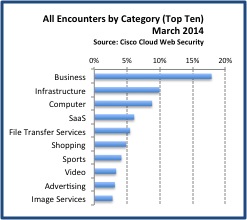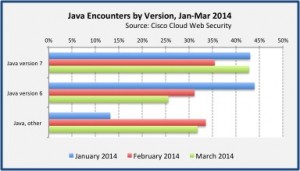































The median rate of web malware encounters in March 2014 was 1:260, compared to a median rate of 1:341 requests in February. At least some of this increased risk appears to have been a result of interest in the NCAA tournaments (aka March Madness), which kicked off during the second week of March in the United States.

In February 2014, web malware encounters from sports and video sites were in the 18 and 28 spot, respectively. During March 2014, web malware from sports- and video-related sites jumped to the number 7 and 8 spots, respectively. The presumed longer time spent viewing sports-related content may have been a factor in a 1% decrease in the total volume of web requests in March coupled with a corresponding 18% increase in terabytes received.

The ratio of unique non-malicious hosts to unique malware hosts decreased by 1%, at 1:4841 in March 2014 compared to 1:4775 in February. The ratio of unique non-malicious IP addresses to malicious unique IP addresses also dropped from 1:1351 in February 2014 to 1:1388 in March. There was also far less volatility in the rate of unique malicious IP addresses throughout March compared to February.

Java encounters dropped from 9% of all web malware encounters in February 2014 to 6% in March. At 43% of all Java encounters, Java version 7 exploits were the most frequently encountered, with 26% targeting Java version 6, and 32% targeting other versions of Java.

Web malware encounters from mobile devices decreased 24% from February to March 2014. In March 3.6% of all Web malware encounters resulted from mobile device browsing, compared to 4.7% in February. Conversely, web malware encounters from non-Android and non-iOS devices doubled for the period, from 0.1% in February to 0.2% in March. The cause of this increase was not due to any specific device, but rather an across-the-board increase affecting all non-Android and non-iOS devices.

At 18%, advertising was the most common vector of mobile device encounters, followed by business-related sites at 13% and video-related sites at 11% of mobile device encounters. For comparison purposes, in February 2014, sites in the business category were the most common vector of mobile device encounters (20%), followed by advertising (13%) and personal sites (8%). Video came in fourth in February, at 7%.

Pharmaceutical & Chemical remained at 1100% of median risk for web malware encounters in March 2014, the same rate experienced in February. Companies in the Entertainment vertical experienced an increase from 321% in February to 643% in March. The Energy, Oil & Gas vertical increased from a rate of 276% in February to 397% in March.
To assess vertical risk, we first calculate the median encounter rate for all enterprises, and then calculate the median encounter rate for all enterprises in a particular vertical, then compare the two. A rate higher than 100% is considered an increased risk.

Following a 73% increase from January to February, spam volumes increased another 45% in March to an average of 207 billion spam messages per day.

The top five global spam senders in February 2014 were the United States at 8%, followed by the Republic of Korea at 5%, Russian Federation at 3%, China at 2%, and Ukraine at 1%.
 Горячие метки:
Безопасность и охрана
malware
TRAC
CSIRT
metrics
Threat Metrics 2014
Горячие метки:
Безопасность и охрана
malware
TRAC
CSIRT
metrics
Threat Metrics 2014